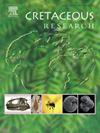A giant spinosaurid from the Iberian Peninsula and new data on the Early Cretaceous Iberian non-avian theropod palaeodiversity
IF 1.7
3区 地球科学
Q1 GEOLOGY
引用次数: 0
Abstract
Despite some exceptional cases, the Lower Cretaceous theropod record from Iberia mainly comprises isolated teeth and fragmentary skeletons. In the Cameros Basin, theropods have been mostly documented in the Eastern Cameros sub-basin with baryonychine spinosaurids dominating this sector. Instead, theropods are rarer in the Western Cameros sub-basin. Here, we describe material from the Western Cameros sub-basin, recovered in the upper Hauterivian–lower Barremian Golmayo Formation of Soria (Los Caños and Zorralbo I sites), which allowed us to identify three early-branching tetanuran and three baryonychine dental morphotypes, and a large-sized spinosaurid from Zorralbo I. The latter is represented by cranial, axial, and appendicular bones, and identified as a large-sized baryonychine based on anatomical and phylogenetic studies. Our results demonstrate that the theropod assemblages are consistent within the entire Cameros Basin, exhibiting a dominance of baryonychines. Western Cameros theropods are not only limited to Baryonychinae but they would also coexist with other early-branching tetanurans and coelurosaurians. The Lower Cretaceous Iberian record is represented by taxa from all major clades within Theropoda (i.e., Tetanurae, Allosauroidea, Carcharodontosauria, Coelurosauria, Ornithomimosauria, Paraves and Dromaeosauridae), being Spinosauridae the most prevalent group, with five described genera and species and a large number of tooth morphotypes. Indeed, three spinosaurine and ten baryonychine tooth morphotypes have been identified in the Iberian record so far. This study demonstrates that the entire Cameros Basin has a great representation of the theropod record of the Iberian Peninsula, and it underscores the potential of this basin to understand the Iberian palaeobiodiversity, especially in spinosaurids.
来自伊比利亚半岛的巨型棘龙和早白垩纪伊比利亚非鸟类兽脚亚目古多样性的新数据
除了一些例外,伊比利亚的下白垩纪兽脚亚目记录主要包括孤立的牙齿和碎片骨架。在喀麦隆盆地,兽脚亚目主要分布在东喀麦隆次盆地,重onyche棘龙类在该区域占主导地位。相反,兽脚亚目恐龙在喀麦隆西部亚盆地中更为罕见。在这里,我们描述了来自西喀麦隆次盆地的材料,这些材料是在Soria的上hauterivian -下Barremian Golmayo组(Los Caños和Zorralbo I遗址)中发现的,这使我们能够识别出三种早期分支的强骨龙和三种重晶石牙齿形态,以及一种来自Zorralbo I的大型棘龙,后者以颅骨、轴骨和尾骨为代表,并根据解剖学和系统发育研究确定为一种大型重晶石。我们的研究结果表明,兽脚亚目在整个喀麦隆盆地的组合是一致的,表现出重石目的优势。喀麦隆西部的兽脚亚目不仅局限于重金目,而且还与其他早期分支的破伤风目和硬骨龙目共存。下白垩世伊比利亚半岛的记录包括兽足目所有主要分支的分类群(即破伤风科、异龙科、Carcharodontosauria、Coelurosauria、Ornithomimosauria、Paraves和Dromaeosauridae),其中棘龙科是最普遍的类群,有5个已描述的属和种和大量的牙齿形态。事实上,到目前为止,在伊比利亚的记录中已经确定了三种棘龙和十种重晶石的牙齿形态。该研究表明,整个喀麦隆盆地具有伊比利亚半岛兽脚亚目记录的代表性,并强调了该盆地在了解伊比利亚半岛古生物多样性,特别是棘龙类方面的潜力。
本文章由计算机程序翻译,如有差异,请以英文原文为准。
求助全文
约1分钟内获得全文
求助全文
来源期刊

Cretaceous Research
地学-地质学
CiteScore
4.10
自引率
19.00%
发文量
235
审稿时长
12 weeks
期刊介绍:
Cretaceous Research provides a forum for the rapid publication of research on all aspects of the Cretaceous Period, including its boundaries with the Jurassic and Palaeogene. Authoritative papers reporting detailed investigations of Cretaceous stratigraphy and palaeontology, studies of regional geology, and reviews of recently published books are complemented by short communications of significant new findings.
Papers submitted to Cretaceous Research should place the research in a broad context, with emphasis placed towards our better understanding of the Cretaceous, that are therefore of interest to the diverse, international readership of the journal. Full length papers that focus solely on a local theme or area will not be accepted for publication; authors of short communications are encouraged to discuss how their findings are of relevance to the Cretaceous on a broad scale.
Research Areas include:
• Regional geology
• Stratigraphy and palaeontology
• Palaeobiology
• Palaeobiogeography
• Palaeoceanography
• Palaeoclimatology
• Evolutionary Palaeoecology
• Geochronology
• Global events.
 求助内容:
求助内容: 应助结果提醒方式:
应助结果提醒方式:


